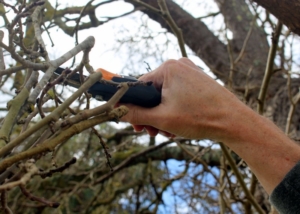Living history
Each time I visit Fairlawn, the home where Georgiana Molloy spent the last few years of her short life, I’m drawn to the garden, for obvious reasons. One tree in particular, a Black mulberry, always pulls me to gaze up at the sky through its lichen-laced branches or to touch its gnarly trunk. Although the tree fell and split at some stage in its long history, it still stands like an ancient, stooping sentinel between the house and the Vasse River, and a few months ago I enjoyed the taste of its ripe fruits. The video I posted on my Facebook page a couple of days ago was taken when Mike and I visited Fairlawn this week to see the Morus nigra once again – for a very special reason!
It doesn’t take an expert to see that the tree’s very old. Fairlawn existed as a cottage for a few years before Georgiana moved there in May 1839 but she began work on planting the first garden herself, so I’ve often wondered whether she planted the Mulberry tree then, before she died in 1843. Soft fruits were an important food crop for the settlers at that time, used fresh in season, for puddings and as jams, wines or preserves during winter.
A few weeks ago, I came across some evidence that made my heart skip a beat. I’d read the words many times before but never made the connection. In a letter Georgiana wrote to James Mangles RN, started in June 1840, she thanked him for the ‘Box of Plants’ he had sent her. She’d just opened it and told him all the fruit trees were ‘gratifying to behold’, some with long shoots and all ‘white, of course, from the exclusion of light’ during their long sea voyage. She went on to describe ‘the Black mulberries, literally with green shoots’.


Given her excitement, and the difficulty of acquiring healthy fruit trees in the colony at that time, it doesn’t seem like a leap of assumption to believe that she planted in her own garden the Morus nigra that Mangles sent her. Mulberry trees usually take well and tend to grow vigorously without too much care and attention. In the mild climate at the Vasse and so close to the water table in the flood plain of the river, the young tree was unlikely to fail, especially given her horticultural knowledge and its position near the house, handy for any additional watering needed in summer.
Of course, I had to consider the possibility that the tree could’ve been planted after Georgiana’s death in 1843, perhaps by a later inhabitant of Fairlawn. It would be impossible to assess the exact age of the tree without investigating its growth rings but I wondered if a real expert might be able to shed some light. Through the kindness of a botanical-world friend in the UK, I was put in touch with just the ‘tree expert’ I needed and gave him the information he asked for about the tree’s position, climate and soil. I also sent photographs to show its size and dimensions. I asked if he thought it could have been planted in 1840.

He told me the tree certainly looks ‘all of that age’. There’s one at Kew Gardens planted in 1846 and the Fairlawn tree is larger. His last comment, ‘I think you can safely say that it is from 1840 or earlier’, was exactly what I was hoping to hear.
Of course, the Black mulberry at Fairlawn can’t be linked without any doubt at all to the trees Georgiana received from Mangles in 1840, but given the age of the tree we can see today, her comment in the letter, and knowing that it could not have been planted before that time, the provenance is very, very strong.
And if it is the same one, then it’s the only living specimen, still alive and growing, that was planted by her.
Have you guessed yet why I was wearing my gardening gloves in the video?
We were taking cuttings, in the hope that the buds already showing will become green leaves in the next few weeks and the roots will take. If the cuttings make it, they too will be genetically identical to the original tree. They will be clones of the tree Georgiana planted not seedlings. I’ll be watching them carefully, protecting them if necessary. And I’ll keep you posted!


